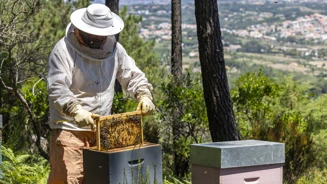The Sintra hills produce honey again after 147 years
06 Dec 2024
In 1877, King Ferdinand II made a request to the treasurer of the royal house of the Park of Pena, instructing that beehives be installed inside the park next to the Countess's Garden. The two letters from the treasurer, dated 11th and 24th November of that year, also stated that the Countess of Edla would define the final location for the hives.
147 years later, Parques de Sintra has recovered the production of honey in the Sintra Hills and is launching Countess of Edla honey on Friday 6 December, which can be purchased in the shops of the monuments managed by Parques de Sintra or in the online shop.
Beehives have an ancient presence in the Sintra hills, reflecting the many years of beekeeping in the region. The project to revive this ancient tradition began in June 2023 with the installation of 11 apiaries, spread across various ecologically and historically important sites. The locations chosen were the Ferdinand II’s hunting grounds, the Saldanha hunting grounds, the Monserrate hunting grounds, and the Forest Perimeter of the Sintra hills, totalling 165 hives.
Honey production is an ancient activity that involves a series of stages that must be carefully followed to guarantee the quality and purity of the final product.
In Parques de Sintra's beekeeping project, this practice is carried out with deep respect for tradition and in accordance with best sustainability and nature conservation practices. The honey produced in these forested hunting grounds promotes short production chains and a circular economy.

